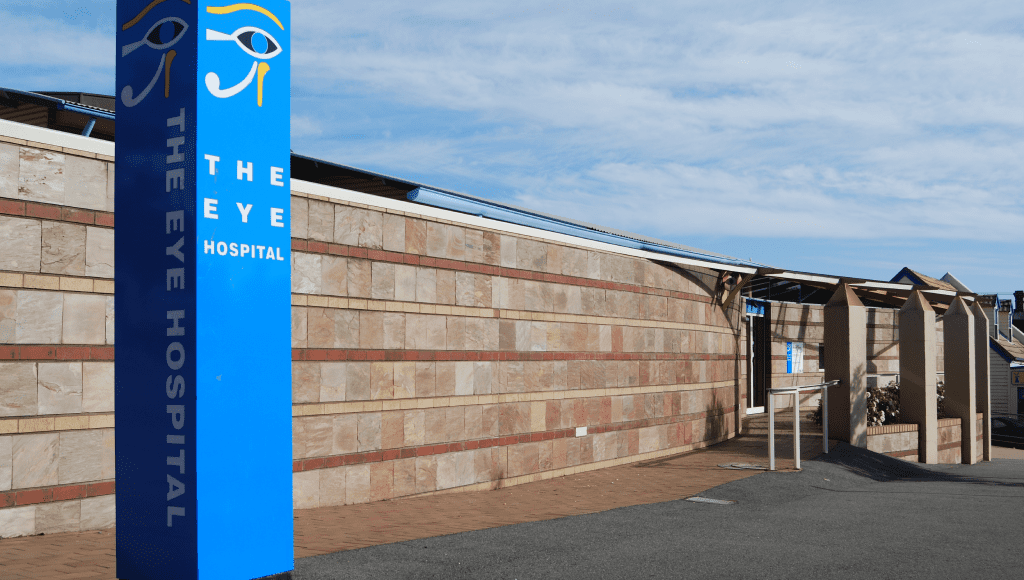Welcome to The Eye Hospital
The Eye Hospital was purpose built in 1993 in Launceston, Tasmania, when the increasingly sophisticated and specialised nature of ophthalmic surgery was recognised. The Eye Hospital was the first registered day procedure centre in Tasmania and has always strived to achieve best practice to ensure patient safety and care.

- Patient Information
- Find a Doctor
- Patient Feedback
- Australian Charter of Healthcare Rights
- Patient Safety and Quality
- Governance
- Online admissions
- Our Procedures
A blepharoplasty is a procedure which removes excess or sagging skin from upper and/or lower eyelids. The surgery is usually performed for cosmetic reasons however; it can improve sight in patients whose eyelids are obscuring their vision.
A chalazion is a lump on the eyelid that is usually caused by obstruction of the drainage duct of an oil gland within the upper or lower eyelid. Surgical removal of chalazion may become necessary if vision becomes obscured, or an astigmatism.
A Dacryocystorhinostomy (DCR) is an operation performed to unblock the nasolacrimal duct (tear duct).
Ectropion is a medical condition where the eyelid folds outward. Corrective surgery involves the removal of a small piece of the fold to tighten the muscles in the area.
Entropion is a medical condition where the eyelid folds inward. Corrective surgery involves the removal of a small piece of the fold to tighten the muscles in the area.
Excision of lesions is a procedure to remove growths such as lesions, moles and tumours from the skin, sometimes accompanied by frozen sections and followed by sutures or a graft. The most common reason for undertaking this procedure is for the removal of skin cancers such as Basal Cell Carcinoma which is the most common skin cancer on the face.
Ptosis is a drooping of the upper eyelid. Corrective surgery is performed by tightening the levator muscle through an incision in the normal crease in the upper lid.
A Punctoplasty is performed to widen the punctual opening to improve the drainage of tears in patients with punctual stenosis (the abnormal narrowing of the lacrimal punctum).
Cataract surgery is the surgical replacement of a cloudy lens with an artificial intraocular lens (IOL) implant to restore vision. The cloudy lens is broken up and removed with an ultrasound probe through a very small incision in the eye, and the artificial lens is inserted.
Enucleation of the eye is the surgical removal of the eye. It is a mostly used as treatment for malignant tumor in the eye or to relieve intolerable pain in a blind eye.
Evisceration is a surgical technique by which all intraocular contents are removed while preserving the scleral shell, and surrounding muscle.
An ICL procedure involves the insertion of an implantable contact lens in the front chamber of the eye, leaving the natural lens intact. The procedure, undertaken to correct short- or long-sightedness, is often used as an alternative to corrective laser procedures.
Intravitreal injections are used in the treatment of Age-Related Macular Degeneration. The Injections work by inhibiting the growth of abnormal blood vessels at the macula, and help to prevent leakage of these blood vessels.
A penetrating keratoplasty, or corneal transplant, replaces diseased or scarred corneal tissue with healthy tissue from an organ donor. Corneal transplants can treat a number of conditions such as keratoconus, Fuchs’ dystrophy, corneal infection, corneal dystrophy and corneal injury or trauma.
A pterygium is a growth of blood vessels and fibrous tissues covering the surface of the eye due to over-exposure to sunlight over an extended period of time. A pterygium is treated with a surgical excision and an auto-conjunctival graft.
A refractive lensectomy or refractive lens exchange, replaces the natural lens with an artificial intraocular lens (IOL) implant. The surgery is usually performed to reduce a patient’s dependence on glasses or contact lenses.
A scleral buckle is when a silicone band is placed on the outer wall of the eye to close a retinal tear. Injections of gas or cryotherapy (intense cold) are also used to assist the buckle in closing the retinal tear.
Squint surgery involves tightening the extraocular eye muscles to change the eye position in order to correct a turned eye.
Glaucoma is characterised by elevated intraocular pressure associated with optic cupping and visual field loss. Trabeculectomy surgery lowers intraocular pressure by forming a new drainage to allow fluid to escape from the eye.
Vitrectomy is a surgery which removes the vitreous gel from the eye to assist in the repair of retinal detachments, macular holes and retinal membrane surgeries.
Dental implants are used to replace damaged or missing teeth. A dental implant procedure is where a screw or metal fixture is implanted into the jaw as the base for a new false tooth.
Dental restoration is a broad term used to encompass any dental procedure, artificial substance or structure with protects the mouth’s ability to eat and chew. The most common form of dental restoration are dental fillings.
When wisdom teeth have the potential to cause problems or become impacted, they may be removed surgically. In the procedure, the surgeon makes a small incision and extracts the tooth with forceps.
A tooth extraction is the removal of a tooth from the dental alveolus (socket) in the alveolar bone.
Contact Details
Opening Hours: 7:00am to 5:30pm, Monday to Thursday and 7:00am to 3:30pm on Friday. Our friendly personnel are always ready to assist with your enquiries.
Tel: (03) 6334 4960
Contact Person: Chris McGee, CEO/Director of Nursing [email protected]
Address: 262 Charles Street, LAUNCESTON TAS 7250
- Follow The Eye Hospital on social




